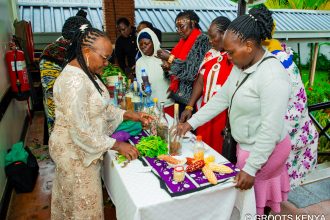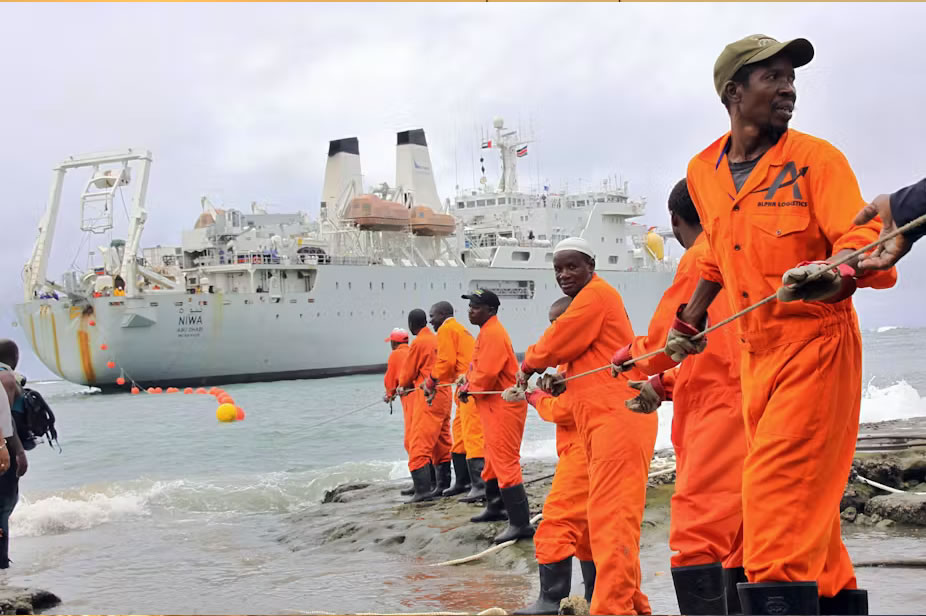Large parts of west and central Africa, as well as some countries in the south of the continent, were left without internet services on 14 March because of failures on four of the fibre optic cables that run below the world’s oceans. Nigeria, Côte d’Ivoire, Liberia, Ghana, Burkina Faso and South Africa were among the worst affected. By midday on 15 March the problem had not been resolved. Microsoft warned its customers that there was a delay in repairing the cables. South Africa’s News24 reported that, while the cause of the damage had not been confirmed, it was believed that “the cables snapped in shallow waters near the Ivory Coast, where fishing vessels are likely to operate”.
Jess Auerbach Jahajeeah, an associate professor at the University of Cape Town’s Graduate School of Business, is currently writing a book on fibre optic cables and digital connectivity. She spent time in late 2023 aboard the ship whose crew is responsible for maintaining most of Africa’s undersea network. She spoke to The Conversation Africa about the importance of these cables.
1. What’s the geographical extent of Africa’s current undersea network?
Fibre optic cables now literally encircle Africa, though some parts of the continent are far better connected than others. This is because both public and private organisations have made major investments in the past ten years.
Based on an interactive map of fibre optic cables, it’s clear that South Africa is in a relatively good position. When the breakages happened, the network was affected for a few hours before the internet traffic was rerouted; a technical process that depends both on there being alternative routes available and corporate agreements in place to enable the rerouting. It’s the same as driving using a tool like Google Maps. If there’s an accident on the road it finds another way to get you to your destination.
But, in several African countries – including Sierra Leone and Liberia – most of the cables don’t have spurs (the equivalent of off-ramps on the road), so only one fibre optic cable actually comes into the country. Internet traffic from these countries basically stops when the cable breaks.
Naturally that has huge implications for every aspect of life, business and even politics. Whilst some communication can be rerouted via satellites, satellite traffic accounts for only about 1% of digital transmissions globally. Even with interventions such as satellite-internet distribution service Starlink it’s still much slower and much more expensive than the connection provided by undersea cables.
Basically all internet for regular people relies on fibre optic cables. Even landlocked countries rely on the network, because they have agreements with countries with landing stations – highly-secured buildings close to the ocean where the cable comes up from underground and is plugged into terrestrial systems. For example southern Africa’s internet comes largely through connections in Melkbosstrand, just outside Cape Town, and Mtunzini in northern KwaZulu-Natal, both in South Africa. Then it’s routed overland to various neighbours.
Each fibre optic cable is extremely expensive to build and to maintain. Depending on the technical specifications (cables can have more or fewer fibre threads and enable different speeds for digital traffic) there are complex legal agreements in place for who is responsible for which aspects of maintenance.
2. What prompted you to write a book about the social history of fibre optic cables in Africa?
I first visited Angola in 2011 to start work for my PhD project. The internet was all but non-existent – sending an email took several minutes at the time. Then I went back in 2013, after the South Atlantic Cable System went into operation. It made an incredible difference: suddenly Angola’s digital ecosystem was up and running and everybody was online.
At the time I was working on social mobility and how people in Angola were improving their lives after a long war. Unsurprisingly, having digital access made all sorts of things possible that simply weren’t imaginable before. I picked up my interest again once I was professionally established, and am now writing it up as a book, Capricious Connections. The title refers to the fact that the cables wouldn’t do anything if it wasn’t for the infrastructure that they plug into at various points.
Landing centres such as Sangano in Angola are fascinating both because of what they do technically (connecting and routing internet traffic all over the country) and because they often highlight the complexities of the digital divide.
For example, Sangano is a remarkable high tech facility run by an incredibly competent and socially engaged company, Angola Cables. Yet the school a few hundred metres from the landing station still doesn’t have electricity.
When we think about the digital divide in Africa, that’s often still the reality: you can bring internet everywhere but if there’s no infrastructure, skills or frameworks to make it accessible, it can remain something abstract even for those who live right beside it.
In terms of history, fibre optic cables follow all sorts of fascinating global precedents. The 2012 cable that connected one side of the Atlantic Ocean to the other is laid almost exactly over the route of the transatlantic slave trade, for example. Much of the basic cable map is layered over the routes of the copper telegraph network that was essential for the British empire in the 1800s.
Most of Africa’s cables are maintained at sea by the remarkable crew of the ship Léon Thévenin. I joined them in late 2023 during a repair operation off the coast of Ghana. These are uniquely skilled artisans and technicians who retrieve and repair cables, sometimes from depths of multiple kilometres under the ocean.
When I spent time with the crew last year, they recounted once accidentally retrieving a section of Victorian-era cable when they were trying to “catch” a much more recent fibre optic line. (Cables are retrieved in many ways; one way is with a grapnel-like hook that is dragged along the ocean bed in roughly the right location until it snags the cable.)
There are some very interesting questions emerging now about what is commonly called digital colonialism. In an environment where data is often referred to with terms like “the new oil”, we’re seeing an important change in digital infrastructure.
Previously cables were usually financed by a combination of public and private sector partnerships, but now big private companies such as Alphabet, Meta and Huawei are increasingly financing cable infrastructure. That has serious implications for control and monitoring of digital infrastructure.
Given we all depend so much on digital tools, poorer countries often have little choice but to accept the terms and conditions of wealthy corporate entities. That’s potentially incredibly dangerous for African digital sovereignty, and is something we should be seeing a lot more public conversation about.




